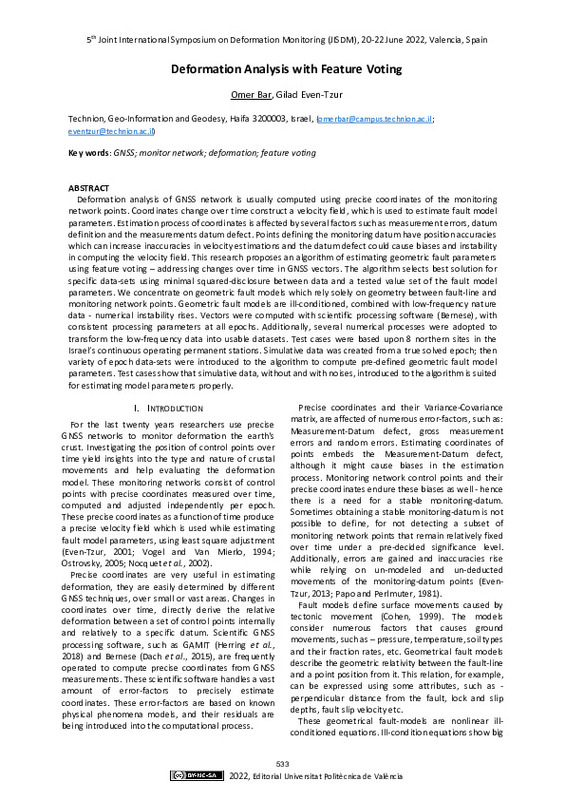JavaScript is disabled for your browser. Some features of this site may not work without it.
Buscar en RiuNet
Listar
Mi cuenta
Estadísticas
Ayuda RiuNet
Admin. UPV
Deformation Analysis with Feature Voting
Mostrar el registro sencillo del ítem
Ficheros en el ítem
| dc.contributor.author | Bar, Omer
|
es_ES |
| dc.contributor.author | Even-Tzur, Gilad
|
es_ES |
| dc.date.accessioned | 2023-03-06T10:11:02Z | |
| dc.date.available | 2023-03-06T10:11:02Z | |
| dc.date.issued | 2023-01-27 | |
| dc.identifier.isbn | 9788490489796 | |
| dc.identifier.uri | http://hdl.handle.net/10251/192316 | |
| dc.description.abstract | [EN] Deformation analysis of GNSS network is usually computed using precise coordinates of the monitoring network points. Coordinates change over time construct a velocity field, which is used to estimate fault model parameters. Estimation process of coordinates is affected by several factors such as measurement errors, datum definition and the measurements datum defect. Points defining the monitoring datum have position accuracies which can increase inaccuracies in velocity estimations and the datum defect could cause biases and instability in computing the velocity field. This research proposes an algorithm of estimating geometric fault parameters using feature voting – addressing changes over time in GNSS vectors. The algorithm selects best solution for specific data-sets using minimal squared-disclosure between data and a tested value set of the fault model parameters. We concentrate on geometric fault models which rely solely on geometry between fault-line and monitoring network points. Geometric fault models are ill-conditioned, combined with low-frequency nature data - numerical instability rises. Vectors were computed with scientific processing software (Bernese), with consistent processing parameters at all epochs. Additionally, several numerical processes were adopted to transform the low-frequency data into usable datasets. Test cases were based upon 8 northern sites in the Israel’s continuous operating permanent stations. Simulative data was created from a true solved epoch; then variety of epoch data-sets were introduced to the algorithm to compute pre-defined geometric fault model parameters. Test cases show that simulative data, without and with noises, introduced to the algorithm is suited for estimating model parameters properly. | es_ES |
| dc.format.extent | 4 | es_ES |
| dc.language | Inglés | es_ES |
| dc.publisher | Editorial Universitat Politècnica de València | es_ES |
| dc.relation.ispartof | 5th Joint International Symposium on Deformation Monitoring (JISDM 2022) | |
| dc.rights | Reconocimiento - No comercial - Compartir igual (by-nc-sa) | es_ES |
| dc.subject | GNSS network | es_ES |
| dc.subject | GNSS | es_ES |
| dc.subject | Monitor network | es_ES |
| dc.subject | Deformation | es_ES |
| dc.subject | Feature voting | es_ES |
| dc.title | Deformation Analysis with Feature Voting | es_ES |
| dc.type | Capítulo de libro | es_ES |
| dc.type | Comunicación en congreso | es_ES |
| dc.rights.accessRights | Abierto | es_ES |
| dc.description.bibliographicCitation | Bar, O.; Even-Tzur, G. (2023). Deformation Analysis with Feature Voting. En 5th Joint International Symposium on Deformation Monitoring (JISDM 2022). Editorial Universitat Politècnica de València. 533-536. http://hdl.handle.net/10251/192316 | es_ES |
| dc.description.accrualMethod | OCS | es_ES |
| dc.relation.conferencename | 5th Joint International Symposium on Deformation Monitoring | es_ES |
| dc.relation.conferencedate | Junio 20-22, 2022 | es_ES |
| dc.relation.conferenceplace | València, España | es_ES |
| dc.relation.publisherversion | http://ocs.editorial.upv.es/index.php/JISDM/JISDM2022/paper/view/13775 | es_ES |
| dc.description.upvformatpinicio | 533 | es_ES |
| dc.description.upvformatpfin | 536 | es_ES |
| dc.type.version | info:eu-repo/semantics/publishedVersion | es_ES |
| dc.relation.pasarela | OCS\13775 | es_ES |






